User Opinions
|
||||||||||||||||||||||||||||||
|
|
|
| Sun Jan 7, 2007 - 6:53 PM EST - By Dieter Bohn | |
|
|
|
|
|||||||||||||||||||||||||||||||
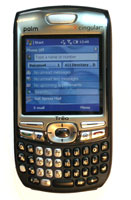
I've been using the new Treo 750 for just a few days now, but it's nearly identical to the Treo 750v (Read TreoCentral's full review here), which has been my "main brain" for quite awhile now. So I'm in a fairly good position, I hope, to give you the full rundown on this device. Is the 750 the Treo for you? It just might be - I'll come out and say right away that it's the Treo for me.
Back in September I anointed the 700wx the best smartphone on the market. Despite the 750's continuance of Palm's "grand" tradition of leaving out WiFi, the 750 has supplanted the 700wx as the best powerhouse smartphone on the market - especially if you live in market where Cingular has provided high-speed UMTS data (See a list here).
If you're new to Windows Mobile, I recommend you read Michael Ducker's review of the Treo 700w, which goes into great depth with how Windows Mobile differs from the Palm OS.
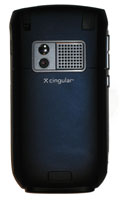
The Treo 750 is identical in almost every way, form-factor-wise, to the Treo 750v. The only difference I can see, besides the obvious fact that there's a "Cingular" icon on this phone instead of a "Vodafone" one, is that the silver area around the screen is just slightly darker. Everything that is good about the 750v is still here: the great soft-touch paint, the excellent form-factor, and the easy-to-use QWERTY keyboard. The phone is 4.4" tall by 2.3" wide by 0.8" deep, and weighs in in at 5.4 ounces (14% lighter than the 650, Palm is eager to tell you). These dimensions don't really give the 750 justice, though, as Palm has clearly worked very hard to sculpt the corners of the device: it sits very nicely in the hand.

There is a barely noticeable difference between the Treo 680 and the 750 in terms of the bulk at the top-rear of the phone, due primarily to the gigantic multi-band radio in the 750. This large radio also necessitates that the 750 use mini-SD instead of standard SD for memory expansion. I find this a little disappointing, but compared to the micro-SD found on many Windows Mobile devices, it's a step up.
Like the Treo 680 (review here), also recently released on Cingular, the 750 has done away with an external antenna. Unlike the 680, however, the radio inside the 750 is quad-band GSM and a tri-band UMTS. The 750 will support data in 115 countries as well as voice in 190 countries. The improved radio gives the 750 3G data speeds in 160 markets in the US (see below), and an update to provide the phone with even-faster HSDPA data speeds is expected later this year (for more on that GSM, UMTS, and HSDPA mean, check out Mike Overbo's article on the subject). UMTS, by the way, is the first wireless data standard in the US to support simultaneous voice and data.
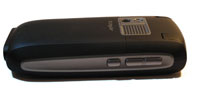

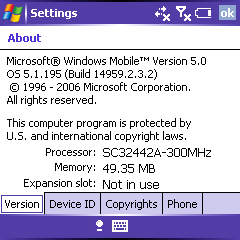
Internally, the 750 also doesn't have any surprises. Program memory (the bane of the Verizon-only Treo 700w) is a capacious 50 megs, plenty for robust multitasking. There is 128mb of non-volatile flash RAM (60mb of which is available for user storage). I'm really happy that pretty much every mobile device these days uses non-volatile flash memory - it's hard to believe that we once allowed ourselves to buy gadgets that lost their data when the battery died.
Speaking of the battery, it is a relatively (compared to the Treo 650) small one at 1200 mAh. The battery is, of course, lithium ion. Palm says that this should give you about 4 hours of talk time and 250 hours of standby - though it's likely that if you're in a market with 3G UMTS service that standby time may be a bit worse. I'm in Minneapolis, where standard Edge is all we have, and in my usage these numbers are remarkably accurate.
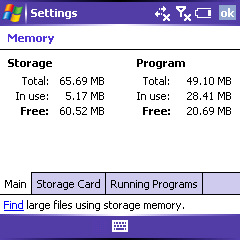
The processor is a 300MHz Samsung, and in my usage its been just fine. I have experienced just a little bit of audio stutter when I use Coreplayer with several other apps open. In general usage, the processor is fine, however. To be perfectly honest, I'm paying less and less attention to the processor specs in smartphones these days - performance always seems to be throttled by RAM well before the processor becomes a hassle.
The camera is 1.3 megapixels and it performs about how you'd expect: average. There is no little LED-flash, which seems to be the standard these days, but I've always found those flashes next to useless.
The touchscreen is the now-familiar 240x240 pixels; it is bright and readable indoors and fairly decent in direct sunlight. A touchscreen means there's also a stylus, which I find relatively disappointing. Palm decided to shave some weight here, so it's mostly plastic. Strangely, there's an ever-so-subtle creak when you bend the stylus - I'm at a loss to explain either why the creak is there or why it bothers me so much.
Of course, the 750 uses the same universal connector we've all grown to love, so if you already have a Treo (or at least a Treo made since the 600), your chargers and cables will be compatible.
Rounding up the specs, we find Bluetooth 1.2, though it has full support for A2DP stereo over bluetooth. In point of fact, the only functional difference between the 750's bluetooth and bluetooth 2.0 is that bluetooth 2.0 has a higher data throughput. In my testing the 750 performs better than the Treo 650 and the 700w/wx in terms of bluetooth performance. Range, compatibility, and audio quality are all good.
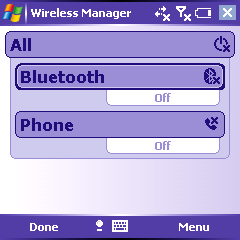
Up until about a month ago, I've defended Palm's decision to not include WiFi support in their Treos. No more. Yes, I understand that WiFi is a significant drain on battery life. I also understand that WM5's WiFi implementation leaves much to be desired. But let's face it, folks, it's become the standard for high-end devices. Every other Windows Mobile phone, be it Pocket PC Edition or Smartphone Edition, comes with a "Wireless Manager" similar to the one found on the Treo. It's dead-simple to just turn WiFi off to preserve battery life.
I also do not believe it's really an issue of form-factor, either. If the T-Mobile Dash and the Cingular Blackjack are able to include WiFi, I don't see a good reason that it can't be added to the Treo. Admittedly, these devices have absolutely horrendous battery life, but they still seem to be selling just fine.

My hunch is that the biggest hurdle right now is that the PalmOS, in its current Garnet incarnation, still isn't able to easily handle both a cellular radio and a WiFi radio. I know it's not that the PalmOS can't handle WiFi itself - I have a T|X and its WiFi implementation is wonderful - much better than the experience on Windows Mobile.
In any case, unless Palm is intending to share the 750's hardware with a PalmOS device in the near future, I see no compelling reason not to add WiFi to the Windows Mobile Treo 750. For Shame.
Copyright 1999-2016 TreoCentral. All rights reserved :
Terms of Use : Privacy Policy
TREO and TreoCentral are trademarks or registered trademarks of palm, Inc. in the United States and other countries;
the TreoCentral mark and domain name are used under license from palm, Inc.
The views expressed on this website are solely those of the proprietor, or
contributors to the site, and do not necessarily reflect the views of palm, Inc.
Read Merciful by Casey Adolfsson